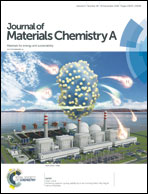Lithium poly-acrylic acid as a fast Li+ transport media and a highly stable aqueous binder for Li3V2(PO4)3 cathode electrodes†
Abstract
Li3V2(PO4)3 (LVP) has been highlighted as a promising cathode material for lithium ion batteries, but it suffers from poor rate capability and rapid capacity decay due to sluggish electrode kinetics and vigorous electrode/electrolyte side reactions at high voltage. In this study, an inexpensive aqueous lithium poly-acrylic acid (LiPAA) binder was developed to deftly solve the shortcomings of the LVP material by tailoring the functional groups in the binder. The good adhesion and cohesion properties of the LiPAA binder ensured a close linkage between the active LVP particles, conductive additives and current collector, which formed a stable and conductive network in the electrode. In addition, the reversible H+/Li+ exchange in LiPAA effectively assisted the transport of Li+ ions at the electrode interface, which allowed the establishment of a Li+ conductive pathway without considerable degradation of the electrolyte. Due to these advantages, the LVP electrode containing the LiPAA binder exhibited significantly improved electrochemical performance compared to the electrode that employed the traditional polyvinylidene fluoride binder. The new electrode configuration showed a large specific capacity of 107 mA h g−1 at 70C rate and a high capacity retention of 91% was obtained after 1400 cycles at 10C rate, showcasing the great potential of this aqueous binder in lithium ion batteries.

- This article is part of the themed collection: 2018 Journal of Materials Chemistry A HOT Papers


 Please wait while we load your content...
Please wait while we load your content...